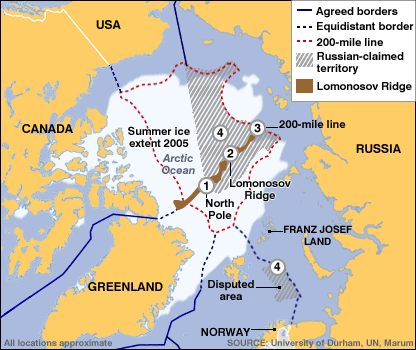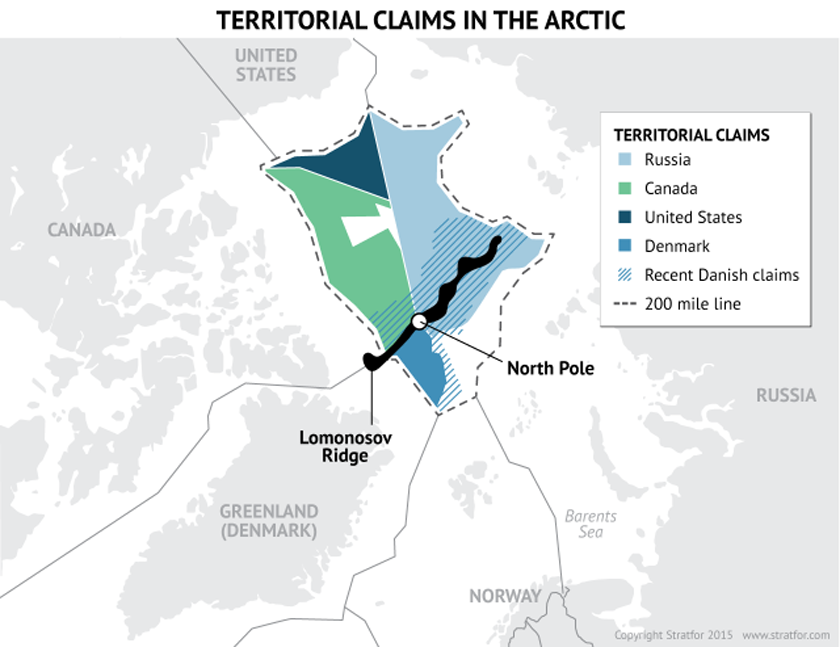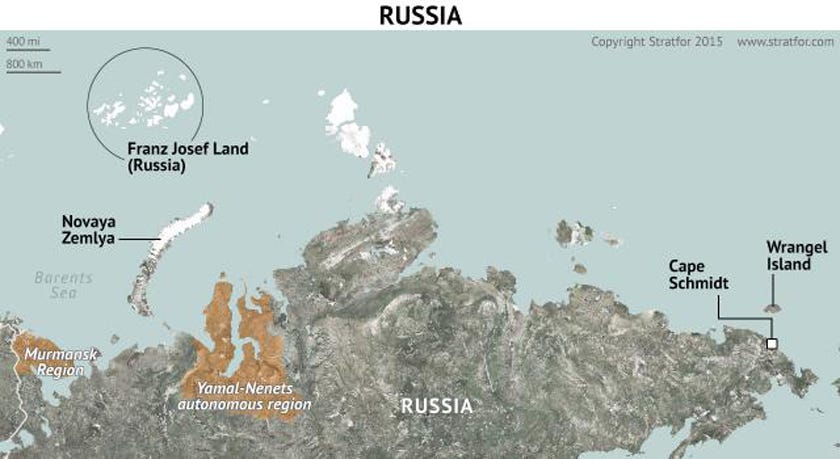Raphael
SENIOR MEMBER

- Joined
- Mar 1, 2012
- Messages
- 3,287
- Reaction score
- 5
- Country
- Location
http://myidst.com/index.php/en/thre...oming-a-dominant-military-power-in-the-arctic
As the Global warming is melting the Arctic ice, and opening up new shipping trade routes and real estate, intense resource competition over an estimated $1 trillion in hydrocarbons has started. This is leading to bitter disputes among countries sharing territory in the polar region, or members of the Arctic council, namely US, Denmark, Iceland, Finland, Norway, Sweden, Russia and Canada. Putin and the Russian Federation are laying disputed claims to territories both inside and outside the Arctic. Canada is preparing to include the North Pole as part of its Arctic Ocean seabed claim.
Putin is actively pursuing a strong approach to the Arctic region, he has named Arctic among the government's top priorities. The declining revenues of the oil fields, are forcing Russian oil companies to actively explore the Arctic region. Russia will create forces in the Arctic to ensure military security and protect the country's national interests in the region.
Russia does not pose security risk to Sweden, according to its Premier Fredrik Reinfeldt. Over the years its military has been weakened by consistent lower defense spending and decisions like downsizing its Air Force, from 20 squadrons and 400 aircraft to four divisions with fewer than 140 front-line fighters.
Canada has a small Arctic military presence, with a training centre opened last year that only holds 150 soldiers. The Canadian Forces are planning to develop a network of sites throughout the Arctic in order to stockpile equipment if needed and move troops and gear quickly into the region in case of emergency. Recently, Canada's National Defence tested remotely piloted vehicles in the extreme conditions of the High Arctic.
US President Barack Obama in May unveiled a strategy for the Arctic, asserting that nations must protect the region's fragile environment and keep it free from conflict. The plan also made it clear the US does not want to be left behind as the other countries eye natural resources and exploit potential new sea routes. Department of Defense Arctic Strategy, identifyied two supporting objectives to the National Strategy: Ensure security, support safety, and promote defense cooperation, and Prepare for a wide range of challenges and contingencies.
US has a military base in Greenland and a large submarine fleet. US Navy recently released 2014 update Navy Arctic Roadmap according to which the Navy will take deliberate steps to anticipate and prepare for Arctic Region operations in the near-term (2014-2020), mid-term (2020-2030), and far-term (beyond 2030). The US Navy plans to transition its Arctic Ocean operations from a capability to provide a periodic presence to a capability to operate deliberately for sustained periods only in the middle and long term.
Hillary Clinton, former Secretary of State, has called for a united Canadian-U.S. counterbalance to Russia's Arctic presence, pointing out "they have been aggressively reopening military bases."
Russia is acting quickly to dominate Geostrategic and Military power in the Arctic. It has announced that it was resuming its permanent Arctic military presence, creating a new military command titled Northern Fleet – Joint Strategic Command, tasked to protect Russian interests in its Arctic territories. It is stepping up its military presence by creating naval bases that would be home to ships and submarines. Russia will have full radar coverage of the Arctic region this year. Russia is also attempting to accelerate the construction of more icebreakers to take part in its Arctic strategy.It has launched restoration of airfields recently at the Novosibirsk Islands and on Franz Josef Land.
Norway has made High North a top defense priority and modernizing its High North defense capabilities, according to Prime Minister Jens Stoltenberg. Norway has also urged NATO to work more closely with the country's military to improve the alliance's level of knowledge and situational awareness in the High North.
However, NATO Secretary-General Anders Fogh Rasmussen said "At this present time, NATO has no intention of raising its presence and activities in the High North". He further said that tensions in the region, and the potential for disputes over the sovereign rights to the region's estimated vast oil and natural gas resources, could be best handled through dialogue. "The Arctic is a harsh environment. It rewards cooperation, not confrontation," Rasmussen said. "I trust we'll continue to see cooperation."
------------------------------------------
If Russia captures the Arctic, let's hope it starts drilling for oil immediately and at full capacity. Then, maybe they could sell it to us with a small "friend's discount".
As the Global warming is melting the Arctic ice, and opening up new shipping trade routes and real estate, intense resource competition over an estimated $1 trillion in hydrocarbons has started. This is leading to bitter disputes among countries sharing territory in the polar region, or members of the Arctic council, namely US, Denmark, Iceland, Finland, Norway, Sweden, Russia and Canada. Putin and the Russian Federation are laying disputed claims to territories both inside and outside the Arctic. Canada is preparing to include the North Pole as part of its Arctic Ocean seabed claim.
Putin is actively pursuing a strong approach to the Arctic region, he has named Arctic among the government's top priorities. The declining revenues of the oil fields, are forcing Russian oil companies to actively explore the Arctic region. Russia will create forces in the Arctic to ensure military security and protect the country's national interests in the region.
Russia does not pose security risk to Sweden, according to its Premier Fredrik Reinfeldt. Over the years its military has been weakened by consistent lower defense spending and decisions like downsizing its Air Force, from 20 squadrons and 400 aircraft to four divisions with fewer than 140 front-line fighters.
Canada has a small Arctic military presence, with a training centre opened last year that only holds 150 soldiers. The Canadian Forces are planning to develop a network of sites throughout the Arctic in order to stockpile equipment if needed and move troops and gear quickly into the region in case of emergency. Recently, Canada's National Defence tested remotely piloted vehicles in the extreme conditions of the High Arctic.
US President Barack Obama in May unveiled a strategy for the Arctic, asserting that nations must protect the region's fragile environment and keep it free from conflict. The plan also made it clear the US does not want to be left behind as the other countries eye natural resources and exploit potential new sea routes. Department of Defense Arctic Strategy, identifyied two supporting objectives to the National Strategy: Ensure security, support safety, and promote defense cooperation, and Prepare for a wide range of challenges and contingencies.
US has a military base in Greenland and a large submarine fleet. US Navy recently released 2014 update Navy Arctic Roadmap according to which the Navy will take deliberate steps to anticipate and prepare for Arctic Region operations in the near-term (2014-2020), mid-term (2020-2030), and far-term (beyond 2030). The US Navy plans to transition its Arctic Ocean operations from a capability to provide a periodic presence to a capability to operate deliberately for sustained periods only in the middle and long term.
Hillary Clinton, former Secretary of State, has called for a united Canadian-U.S. counterbalance to Russia's Arctic presence, pointing out "they have been aggressively reopening military bases."
Russia is acting quickly to dominate Geostrategic and Military power in the Arctic. It has announced that it was resuming its permanent Arctic military presence, creating a new military command titled Northern Fleet – Joint Strategic Command, tasked to protect Russian interests in its Arctic territories. It is stepping up its military presence by creating naval bases that would be home to ships and submarines. Russia will have full radar coverage of the Arctic region this year. Russia is also attempting to accelerate the construction of more icebreakers to take part in its Arctic strategy.It has launched restoration of airfields recently at the Novosibirsk Islands and on Franz Josef Land.
Norway has made High North a top defense priority and modernizing its High North defense capabilities, according to Prime Minister Jens Stoltenberg. Norway has also urged NATO to work more closely with the country's military to improve the alliance's level of knowledge and situational awareness in the High North.
However, NATO Secretary-General Anders Fogh Rasmussen said "At this present time, NATO has no intention of raising its presence and activities in the High North". He further said that tensions in the region, and the potential for disputes over the sovereign rights to the region's estimated vast oil and natural gas resources, could be best handled through dialogue. "The Arctic is a harsh environment. It rewards cooperation, not confrontation," Rasmussen said. "I trust we'll continue to see cooperation."
------------------------------------------
If Russia captures the Arctic, let's hope it starts drilling for oil immediately and at full capacity. Then, maybe they could sell it to us with a small "friend's discount".












